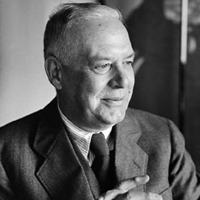Peter Quince at Clavier by Wallace Stevens: Summary and Analysis
The poem 'Peter Quince at Clavier' is a meditative poem based on two allusions: one from Shakespeare's play A Midsummer Night's Dream and the other from the Bible. The Shakespearean character Peter Quince was a rustic actor who clumsily performed a tragedy within the comic play.

Wallace Stevens (1879-1955)
The other character Susanna taken from the bible is a girl who refused to be seduced by two Hebrew old men (judges) and was falsely accused of an immoral relation with someone else. The poem is a soliloquy of Peter, who is attempting to play music; he muses on the power and meaning of music. In this instance, he also remembers the tempting body of Susanna; his desires are roused by the passionate music. The speaker also thinks of 'desire' and music from the viewpoint of the elders who tried to seduce Susanna; this may be objectionable, but Stevens makes a point of being frank about how the mind does actually behave! He talks in mixed terms of music and desire, as if both were one or the same. In the second part of the poem, the character goes on to muse on the girl's body. In the third, he mentions how she was rescued amidst music. The last section is a kind of philosophizing, out of the musing: the poet claims that the beauty of the mind is temporary but the beauty of the body is everlasting. There are also claims that music is a feeling, not sound. With its precise emphasis of meaning and emotion supported by variations in rhythm and sound, Stevens creates a remarkable example of images his musical in this poem. The poem is not so difficult if we are to understand the main 'ideas', but the issues related to music are actually mysterious to readers unfamiliar with the hard-core theories of music itself.
The poet affirms his faith in the physical, concrete, immediate and the real: this partly justifies the carnal desire of the poem's speaker. The self-contained part has reasoned logic of a sonnet. The argument is: Beauty is momentary in our minds, while in the physical body it is immortal". One would have expected the poet to say just the opposite: the poem tells us that flesh and immortality are not at odds as is normally thought. The poet explains it, four times until one accepts the subtle truth of the argument. Bodies do die, but other bodies take their place; so do evenings and maidens.
"Peter Quince at the Clavier" is Wallace Stevens' recounting of the story of Susannah, the story of how a private place is violated. Here there is tension, tension that is obvious in the poem's plot, its rhetoric, and its uncertainty about its own possible comedy. We take a long time to hear the odd disjunctions between the figures of Peter Quince and the red-eyed elders.
The poem's opening in narrative takes place in a pool or, where a lover is making love at the keyboard. Immediately, the poem jumps to a mythic time (part II) in which a woman is made love to by bawdy, red-eyed elders. Formally one is presented with a way of knowing the Susanna's story by the juxtaposition of a modem lover with ancient lustful old men in the tale. The poem is an attempt to justify the apparently odd sounding idea: "Beauty is momentary in the mind but immortal in the flesh."
The poem heavily plays with imagination, music and myth to express the suppressed – the fundamental desires of the libido while consecrating the abused woman by treating in immortal terms of music and feelings. It is part of the general movement to bring music and poetry closer together. Stevens, the musical Imagist, has created in "Peter Quince" his own more brief "symphony”. In contrast to the tenderly reflective music of the beginning of the first section there is at the end the sudden intrusion of the elder’s bass music. The throbbing and pulsing are made aurally acute all well as comic by the repetition of the b and p sounds.
Cite this Page!
Shrestha, Roma. "Peter Quince at Clavier by Wallace Stevens: Summary and Analysis." BachelorandMaster, 23 Mar. 2018, bachelorandmaster.com/britishandamericanpoetry/peter-quince-at-clavier-summary-analysis.html.
